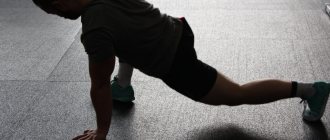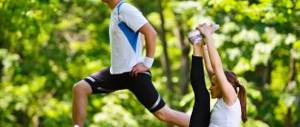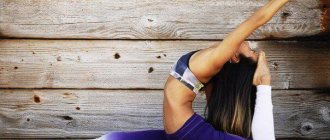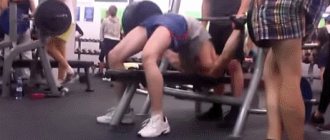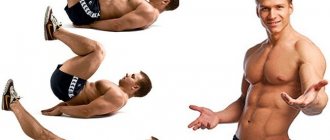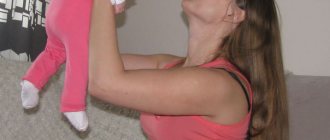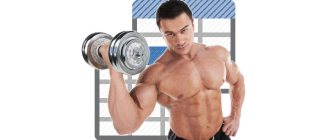Splits are not just a spectacular pose, but also beneficial for the body. Despite the fact that it is considered the prerogative of only ballerinas and gymnasts, mere mortals often want to master this rather difficult position. No one will be able to do the splits without preparation, and even if they succeed, a very dangerous injury is possible, so initially you need to work on stretching. Some people are naturally good at it, some, for example, the same ballerinas and gymnasts, diligently train it since childhood, and some people, not for nothing, consider themselves to be “wooden”, since they are not good at stretching. But even the latter can achieve excellent flexibility; all this is a matter of time and diligence. And a proper warm-up for the splits helps with this, the importance of which cannot be underestimated.
Why do you need a warm-up before the splits?
You need to understand that warming up before doing the splits is a must! Without it, you risk serious injury, and it also helps improve strength. The importance of warming up before doing the splits can be compared to the importance of washing your hands before eating. In the absence of this, unpleasant consequences are possible. The warm-up for the split stretch must be done, and done correctly. In addition to your safety, it will help you do the splits faster, although it is worth noting that rushing here may be inappropriate.
Warming up before stretching has the following benefits :
- improves muscle plasticity;
- improves blood circulation and saturates muscles with oxygen, and the latter in turn minimizes the amount of lactic acid;
- increases flexibility of joints and tendons;
- significantly reduces the risk of injury;
- increases the performance of muscle fibers.
Please note that warming up before the splits is necessary even for those who can already do the splits without any problems. And those who are just taking steps towards this goal should pay maximum attention to it. In order for the muscles to warm up and joint stiffness to go away, just ten minutes of preparation is enough. In addition, you need to take care of the cool-down: finish the exercise with relaxing movements and a light muscle massage.
Warm up. Why should you do it?
Many people think that when time is limited or some other opportunities are limited, it is better to immediately spend time on training. Immediately start running speed segments or doing exercises with a barbell. Why waste time doing some special exercises. Usually only a serious injury convinces a person of the importance of additional exercise.
Stretching , or simply stretching in Russian, reduces muscle tension and improves muscle elasticity.
This reduces the risk of injury and pain. As you know, tense muscles are not sufficiently supplied with oxygen and take longer to recover, which can cause negative health consequences. For example, prolonged running sometimes leads to tightness of the posterior muscle groups (gluteal, calf). Therefore, sprains and damage to connective tissues are possible. Therefore, the main purpose of additional exercises is to prevent various types of injuries. Therefore, it is important to warm up before starting a workout and cool down at the end of the workout.
The benefits and harms of stretching It can be clearly noted that if the training is carried out correctly, stretching cannot cause any harm to the body.
On the contrary, this is a purely positive event with a number of positive aspects. It is for this reason that stretching is included in the daily training program of professional athletes, helping to avoid traumatic incidents, tone muscles and maintain shape. No one is immune from injury, especially for older people, because with age a person becomes less flexible. It is obvious that physically less active people tend to have less flexibility, and people who lead a sedentary lifestyle tend to lose flexibility and freedom of movement over the years. Therefore, spending 10-15 minutes on stretching and flexibility exercises will not hurt anyone.
The benefits of regular stretching include ease of movement and correct posture, the ability to compensate for flexibility lost with age, and a reduced risk of muscle strain and injury.
Warm-up for splits: indications and contraindications
With any physical activity, it is extremely important to consider your body's starting state and give it a load that it can handle. In order for training aimed at doing the splits to be effective and safe, the muscles and joints must be prepared for the upcoming loads.
If muscles are not used during everyday movements, the body becomes weaker. To prevent this, you need to stress absolutely all the muscles and joints of the body. The ability to do the splits is precisely an indicator of excellent health of the ligaments and joints.
It’s not for nothing that splits are included in many programs of therapeutic and preventive physical education. This type of stretching can be used by both absolutely healthy people and those who have medical indications . The list of the latter includes the following:
- Lack of abdominal muscle tone, need for stimulation of internal organs.
- Compensation for overexertion due to lack of mobility and inactive lifestyle.
- Low level of mobility of the hip joints, caused by trauma in the past.
Not everyone can do the splits. Contraindications in this case include injuries and inflammatory processes in the knees, ligaments and tendons of the groin, spinal injuries, abnormalities of the hip joints, as well as exacerbation of gynecological diseases.
Secrets of training effectiveness
Initially, the warm-up before stretching into the splits, as well as the splits pose itself, should assume the correct starting position. The legs should be spicy, the heels should rest on the floor. The body should not bend, and both hands should take part in the safety net.
A warm-up for stretching should begin with actively warming up the muscles for ten minutes. This can be, in fact, any active exercises before the main stretching, preparing the body for training. You can alternate between jumping, running in place and squats, which help work all muscle groups and prepare them for stretching. Mages with legs forward, backward and to the sides also work well. Watch your body position and straight posture - let the amplitude of the swings increase gradually.
There are general rules on which a splits warm-up for beginners at home should be based:
- It is better to exercise in the evening . In the afternoon, the muscles are better ready for stretching than in the morning.
- The ideal option is to practice in front of a mirror and with a partner. It should help you keep your balance and rise, connect with your body position and a straight back, help fix your body and increase resistance. A mirror is necessary so that you can control your position and, if necessary, immediately correct mistakes.
- Exercise every day. It is better for the splits warm-up for beginners to be short, but regular, rather than long, but from time to time.
- Remember the rule of gradualism. Increase the range of movements slowly so that the load brings pleasant fatigue. Pain may be present, but it should be within reason.
- When trying to do the splits, you need to lean on your hands. This will ensure a smooth stretch and help avoid jerking.
- For beginners, it is better to start with cross splits - it is much simpler. It is better to move on to the longitudinal one when the muscles and connections have already acquired the necessary plasticity.
- An effective warm-up before stretching for beginners can include squats, body bends, lunges, rolls, plie exercises - a deep squat with the center of gravity transferred from one leg to the other.
- After you have already managed to do the splits, do not stop the exercises, otherwise the muscles will lose their acquired elasticity, and deep stretching will again become problematic for you.
Start of warm-up
- It takes 3-5 minutes to activate basic physiological functions - breathing, heart function, increasing blood temperature. Usually this is light jogging. In the gym, this could be running on a treadmill, walking on an elliptical machine, or jumping rope.
- Stretching is performed to prepare muscles, tendons, and ligaments. The duration of the warm-up is 10-15 minutes. These are usually stretching and flexibility exercises.
Stretching allows you to increase a person’s overall motor activity, which always has a beneficial effect on joints and serves as an excellent prevention of bone fragility. Stretching strengthens the heart, respiratory system, and increases body and muscle temperature. Stretching is also necessary for relaxation - they dull pain that may occur after training.
Stretching exercises before cross splits
Warm-up for cross splits may include the following exercises :
- Bend forward, in which your back should be straight and your hands should touch the floor.
- Squats with forward lunge. Keep one leg bent at the knee in front, the other straight behind. In this position you need to sit as deeply as possible.
- Squats-lunges, side rolls. The body weight should be alternately transferred from one leg in a bent position to the other.
- Taking a sitting position on the floor, spread your legs as wide as possible. Keep your back straight. You need to clasp your ankles with your hands and pull your chest down towards the floor.
- Place your feet shoulder-width apart, knees out to the sides. Squat as deeply as possible, while keeping the center of gravity of the body above the heels. Alternately shift the weight of your body from one leg to the other. Leave one leg bent at the knee, stretch the other to the maximum.
- Taking a sitting position on the floor, spread your legs as wide as possible, keep your back straight. Join your hands and stretch them forward until your chest touches the floor.
- Spread your legs as wide as possible, bend your arms slightly at the elbows, place them on the floor. It is important to correctly distribute your body weight between your elbows and heels and sit as low as possible until mild pain appears.
Try to hold each position for at least 30 seconds .
Note to parents: split stretching exercises for children
Longitudinal twine stretch
Warming up before the splits at home will be slightly different if the splits are longitudinal. Several other muscle groups will be involved here. We remind you that the longitudinal split is more difficult, so it should only be attempted by those who already have a certain level of training. A stretching warm-up in this case may include the following exercises :
- Lunge in runner's position at the start. The right leg should be bent at a right angle and placed in front. Keep your palms resting near your feet, your extended left leg behind you. Keeping your back straight, try to pull your left heel back as much as possible.
- From the previous position, relax your supporting left knee and rest it on the floor, stretch your feet. Hands need to be moved to the left, elbows placed on the floor. Move your right working knee to the side.
- Stand on your left knee, keeping your body straight. Extend your right leg with your foot pulled towards you, keep your hips straight. Place your hands on the floor, and while inhaling, straighten your shoulders and chest. Exhaling, bend down without bending your back.
- From the previous position, return to a lunge on your right leg, placing your palms on your sacrum. Lower your shoulder blades, bend back, and move your head back too.
- Get into a position on all fours. Extend your right knee until it touches your right wrist. Keep your hips straight. Move your right shin towards the left side of your pelvis and extend your left leg back. Without leaning forward, lower your pelvis as low as possible, pressing your hands to the floor and stretching your waist.
- Stand on your left knee with your right working leg extended forward. Place your hands on the floor, your shoulders and pelvis should be parallel to the floor surface. You need to slide your right foot forward while simultaneously stretching your left leg back. Make sure your back is as straight as possible.
Each exercise should be done with alternating legs. Try to hold the poses for at least 30 seconds.
The presented exercises are suitable both for those who are just trying to do the splits, and for those who can already cope with it. They will help work out ligaments and joints, improve flexibility and stretching. Perform them regularly, trying to stretch harder each time, but controlling the load so as not to provoke severe soreness and injury. A proper warm-up before stretching the splits, the video of which will tell you more about it, will help you achieve your goal.
Warm-up, stretching, warming up and cooling down – are they really important?
Content
Stretching or warming up is the basis of any training plan , which, unfortunately, is often forgotten. At the same time, it plays a really important role in building muscle, reducing muscle mass, and eliminating injuries. Read what stretching techniques we know and what benefits they hide [1] [2]
Difference between stretching, warming up and cooling down
The difference between stretching and warming up before a workout is their purpose. The purpose of stretching is to increase flexibility and range of joints . However, when warming up, it is important to increase body temperature and blood flow to the muscles. Both of these techniques are usually performed before a workout , but you can do post-workout stretches along with a cool-down. However, all three forms of exercise are part of one complex - warm-up.
[1] [2] [3] [4]
Warming up
Warming up before training is important in preventing injuries . Proper warming up revitalizes the cardiovascular system by increasing body temperature and blood flow to the muscles. [2] Warming up also prepares your muscles for the overload of exercise . Keeping your muscles sufficiently warm during the warm-up will increase your range of motion and reduce the risk of injury during exercise . Examples of a good warm-up are aerobic exercise , such as cycling, walking or jogging, which you should do for at least 5-10 minutes.
Cooling
After training, your heart rate increases and your muscles tighten . Therefore, the purpose of cooling is to return the heart rate to normal and prevent the formation of sore throat . An example of cooling down after exercise is, for example, walking quickly and gradually slowing down. Cooling is very important for endurance athletes such as marathon runners because it helps them regulate blood flow in the body after a long period of physical activity.
Stretching
Stretching, stretching the muscles can be done before or after training . Its main pre-workout goal is to improve joint range and reduce the risk of injury during exercise. You can try stretching your entire body or just focus on a specific muscle group that you plan to train later. However, post-workout stretching serves a completely different function, and its purpose is to prevent soreness . Stretching can also be very relaxing, both physically and mentally.
Benefits of stretching and warming up muscles
Improves productivity
By far, the best benefit of stretching or warming up your muscles is how it affects your performance. It helps improve in three effective ways:
- Improves Circulation – Warming up or stretching for 10 minutes improves circulation and opens blood capillaries, which has been linked to improved subsequent physical performance.
- Improves oxygen function - oxygen is released into muscles faster at higher temperatures. If you stretch before your workout, you'll warm up your muscles, which will be ready for peak performance during your workout. If you skip stretching, oxygen can be released into the muscles during exercise over a long period of time, which can negatively impact your performance.
- Accelerates muscle contractions – warming up the muscles before exercise increases body temperature. This leads to better nerve transmission and muscle metabolism. As a result, your muscles will respond faster and more effectively to all stimuli during and after training. [5] [6] [7]
Serves as injury prevention
With an effective and consistent pre-workout warm-up, you relax your joints, increase joint range, and improve blood flow to your muscles . All of these aspects are extremely important in preventing injury . The stiffer and more bloodless your muscles are, the higher your risk of injury during exercise.[5] [6] [7]
Removes heat from the body
Activation of the body's heat removal mechanisms promotes effective muscle cooling , which helps prevent overheating and subsequent overtraining. This benefit is especially important during intense aerobic activity such as running or cycling. [5] [6] [7]
Balances hormone production
During physical activity, the body increases the production of various hormones , including cortisol and adrenaline . They are directly responsible for regulating energy production and your physical performance. If you skip your pre-workout warm-up, these hormones may activate late and have no effect. On the contrary, you can activate them already during the warm-up , which will give your body enough energy during training. [16] You can read about the effect of hormones on the growth and regeneration of muscle mass in our article. How does hormonal imbalance affect muscle mass in men and women?
Cooling Benefits
Supports rapid post-workout recovery
After intense and hard workouts, lactic acid accumulates . This is an organic substance that is formed when glucose is broken down in muscles. At rest, the body produces only a small amount and then moves to the liver, where it is converted back into glucose. However, during increased physical activity, more glucose is produced , which also creates higher levels of lactic acid, which the liver cannot process. Therefore, it accumulates in the muscles and causes cramps , muscle pain or even muscle fever . Therefore, the cooling phase after training helps the process of removing lactic acid from the muscles. Thereby helping to recover faster and preventing the formation of sore throat . [5] [13] Creatine, which also provides energy to muscles , has also been shown to be another excellent way to reduce lactic acid production during exercise.
Reduces delayed onset muscle pain (DOMS)
muscle soreness . Delayed Onset Muscle Soreness (DOMS) usually begins a day or two after training . The pain you experience during or immediately after exercise is another type of muscle pain, also called acute muscle pain . This is due to the aforementioned cause of lactic acid formation and is accompanied by pain immediately after exercise.
DOMS can be caused by any exercise that creates small microscopic tears in muscle fibers. The body responds to this damage by increasing inflammation , which can lead to delayed onset muscle soreness. Symptoms of DOMS or fever to watch for may include:
- sensitive muscles to touch
- decreased range of motion due to pain and stiffness when moving
- swelling of the affected muscles
- muscle fatigue
- short-term loss of muscle strength
Research has shown that effective prevention of DOMS involves cooling down after exercise by warming up and stretching the muscles or massaging specific areas of the stressed muscles. [14] If you want to learn more about muscles and how to prevent them, read our article. Is it true that muscles grow faster after sore throat?
Types of stretching
Just as there are different types of workouts , there are several forms of stretching . During your warm-up, you can focus on static, dynamic, and ballistic stretching . Let's see what the difference is between them. [8] [9]
Static stretching
This is the most common type of stretching . His technique is to stretch a muscle or group of muscles to its farthest point and then maintain that position. This type of stretching is considered the safest way to stretch your muscles. This gives the muscles and connective tissues enough time to relax.
Static stretching is usually performed before strength training , stretching the muscles you intend to train. However, many experts consider this type of stretching to be much less effective than dynamic stretching , since the dynamic warm-up significantly increases the range of motion.
Dynamic stretching
Unlike static stretching, dynamic stretching is a popular way to warm up muscles before aerobic exercise. Dynamic warm-up consists of maximally warming up the muscles by repeating the movement several times in a row . Thus, the purpose of dynamic stretching is to improve flexibility before performing any sport, running, cycling or other aerobic activity. An example of dynamic stretching is, for example, a sprinter who takes extra-long steps before running in order to establish a maximum range of motion for the upcoming power.
Ballistic stretch
Many athletes confuse this type of stretching with dynamic stretching. a significant difference between them . A dynamic warm-up is based on regular, repetitive and intentionally coordinated movements . However, ballistic stretching uses irregular , abrupt, primarily aerobic movements such as intense jumping or sprinting. At the same time, with ballistic stretching, the maximum range of motion limit must be exceeded. However, it is important to note that this type of stretching is more prone to injury and should only be performed by experienced athletes.
Passive stretching
Depending on the type of force applied, stretching can be divided into passive and active. Passive stretching occurs when an external force helps to reach the maximum point of the range. This may occur under the influence of gravity, another person, or a tensioning device such as expanders or suspended reinforcement systems. The point is that the muscle you want to stretch is not subject to primary stress , so you can relax while stretching. Passive stretching is extremely effective for relieving muscle spasms that treat injuries.
Active stretching
Active stretching is characterized by using one's own forces to maintain a stretched position . This is the opposite of passive stretching. For example, raising your legs from the ground in a lying position , and to keep them in the air, use only the strength of your legs. For passive stretching, you can use an arm support , for example, to hold your leg in the air. Thus, active stretching requires more effort but is more effective for building muscle and flexibility.
Myofascial release
This type of stretching uses a foam roller or other massage device. Its application to muscles relieves myofascial tension and improves fascial flexibility . Fascia is a specialized system of connective tissue that connects the entire body . It affects bones, muscles, joints, nerves , and is also located in the brain and spinal cord. Therefore, it is important to take care of the fascial system and stimulate it regularly . Tension at one fascial point also affects more distant locations as it is a closely interconnected system. Therefore, if you feel tension in your calf , consider that this tension is not only in the calf, but also in other parts of the body. [17]
How to do proper and effective stretching
- Duration of stretch - Several studies suggest that stretching or cooling one part of a muscle should take 30 to 60 seconds. [15]
- The number of repetitions depends on several factors, such as your physical condition, age or gender. However, do not overdo the stretching and do as many repetitions as possible. It's important to listen to your body.
- Breathing will help you relax properly. You should inhale slowly before stretching the muscle and exhale slowly as you stretch it. Exhalation should not be forced, but natural.
- When to Stretch – To achieve optimal results and prevent injury, stretching, warming up and cooling down your muscles should be part of every workout plan you have.
Types of stretches by muscle part
You already understand the theory of stretching and warming up muscles, it's time to start training . What should such a stretch ? It all depends on which group you decide to train. However, it is optimal to focus on stretching the entire body. [10] [11] [12]
Full body stretch
The benefit of full body stretching is that no matter what kind of workout you are doing, every muscle will be properly stretched . The basics are to start from the head and gradually move to the feet , without forgetting any muscle part.
You can also watch an example of proper stretching of the whole body before training in the video:
Or try mobility training and roller skating exercises with Jakub Engl:
Stretching individual muscle parts
An increasingly popular technique, especially among bodybuilders and strength enthusiasts, is to target only specific muscle areas with stretches . Especially for those that you are going to strain after stretching. So, look at what stretching the muscles of individual parts of the body should look like .
Stretching focuses on specific muscle areas - shoulders, wrists, hips and ankles:
Feet and Ankles – Many athletes, especially bodybuilders, forget to train this muscle area. These are the muscles directly connected to the calf muscles or hamstrings. They are mainly used for running, cycling, and also for strength training during deadlifts. Therefore, if you don't stretch your feet and ankles properly, you can end up with some nasty injuries.
Stretch for feet and ankles:
Calves – The calf muscles are also often underestimated during warm-ups . At the same time, it is in the calf muscle that muscle cramps most often occur during exercise. A great exercise to warm up is a calf stretch while standing against a wall. Stand facing a wall, step forward with your right foot and leave your left foot facing outward so that you lean forward slightly. Press the heel of your extended back leg into the ground until you feel your calf tighten. Of course, there are many more exercises for the calf muscles, so you can always spice up your warm-up.
Calf stretch:
Hips – here you need to focus on stretching the front and back muscles of the thigh . When stretching the anterior thigh muscles, the “standing leg extension” exercise is effective. Stand on both legs and bend one leg so that your heel touches your sciatic muscles. Then grab your heel with your hands and hold it in this position for at least 30 seconds. During this exercise, you should feel the tension in your anterior thigh muscles . Conversely, if you want to train your back hamstrings or hamstrings, you'll need to focus on a different type of exercise. Sit straight on the ground. Keep your back straight and try to touch your toes. However, do not bend your knees during this exercise, otherwise it will not be effective.
Hip stretch:
Back – when warming up your back, you need to start stretching the cervical spine. This is exactly what many people do, whether it's cardio or strength training. The main type of warm-up is tilting the head forward, backward, left and right. After training the cervical spine, you will go down to the lumbar part, which you will stretch with forward bends and the whole body. You can also use yoga poses to train your neck, cervical spine, and lower back.
Back stretch:
Shoulders, Triceps and Biceps – The basics of the shoulder stretch are to extend your arm, bend it at the elbow and place it behind your head while holding it with your other hand. Of course, this is one of the simplest exercises, but if you have a strenuous shoulder workout at the gym, you should focus on a more comprehensive warm-up . The same goes for the triceps and biceps, which should be given special time when stretching.
Shoulder stretch:
Biceps stretch:
Triceps stretch:
Training plan schedule step by step:
- warming up muscles through short aerobic exercise
- stretching the whole body or a specific muscle group
- self-training
- full body stretching after workout
- cooling
However, keep in mind that without proper execution of individual exercises there will be no results . Therefore, if you decide to include stretching and warm-up in your training plan, which you definitely need to do, carefully study the correct technique for performing the exercises.
We believe that we have provided you with all the important information about stretching, warming up and cooling down your muscles. Do you include a warm-up in your workout plan? Share your experiences in the comments and if you liked the article, don’t forget to share it further.
Sources:
[1] Brad Walker - What is Stretching? How to stretch correctly? When to stretch – https://stretchcoach.com/articles/how-to-stretch/
[2] The Importance of Stretching – https://www.health.harvard.edu/staying-healthy/the-importance-of-stretching
[3] Emily Treen – The difference between stretching and warming up – https://aaptiv.com/magazine/difference-stretching-and-warming-up
[4] Mayo Clinic Staff – Aerobic Exercise: How to Warm Up and Cool Down
– https://www.mayoclinic.org/healthy-lifestyle/fitness/in-depth/exercise/art-20045517
[5] Daniel Bubnis, MS, NASM-CPT, NASE Level II-CSS – Stretching: 9 Benefits, Plus Safety Tips and Where to Start – https://www.healthline.com/health/benefits-of-stretching
[6] Laura Inverarity, DO – Stretching 101: Benefits and Proper Technique – https://www.verywellfit.com/stretching-101-2696342
[7] Healthy Fitness Revolution – Top 10 Health Benefits of Stretching – https://www.healthfitnessrevolution.com/top-10-health-benefits-of-stretching/
[8] Tipi stretching - https://web.mit.edu/tkd/stretch/stretching_4.html
[9] Types of stretch marks - https://us.humankinetics.com/blogs/excerpt/types-of-stretches
[10] Kelsey Cannon – Best Stretch for Every Body Part – https://www.menshealth.com/fitness/a19524299/best-stretch-for-every-body-part/
[11] Amy Marturana Winderl, CPT – 21 Best Stretches for More Flexibility – https://www.self.com/gallery/essential-stretches-slideshow
[12] Stretches to help you relax – https://www.webmd.com/fitness-exercise/ss/slideshow-stretches-to-get-loose
[13] Kyle J. Lampe, Rachel M. Namba, Tyler R. Silverman, Kimberly B. Bjugstad and Melissa J. - Effect of lactic acid on cell proliferation and free radical-induced cell death in monolayer cultures of neuronal progenitor cells – https://www.ncbi.nlm.nih.gov/pmc/articles/PMC2748734/
[14] Gail Olson - What is delayed onset muscle soreness (DOMS) and what can you do about it? – https://www.healthline.com/health/doms
[15] Sandro R. Freitas, João R. Vaz, Paula M. Bruno, Maria João Valamatos, Ricardo J. Andrade, Pedro Mil-Jomens – Are rest intervals between stretching repetitions effective in dramatically increasing range of motion? –https://pubmed.ncbi.nlm.nih.gov/25010018/
[16] ANTHONY K. HACKNEY and ELIZABETH A. WALZ - Hormonal adaptation and exercise stress: the role of glucocorticoids. - https://www.ncbi.nlm.nih.gov/pmc/articles/PMC5988244/
[17] Charlotte Hilton Andersen – 5 Reasons You Should Try Facial Stretching – https://www.shape.com/fitness/tips/fascial-stretching-benefits
